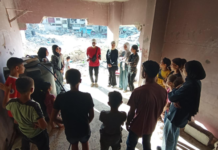Jason Burke
The Guardian / July 12, 2024
People in Batn al-Hawa neighbourhood fear losing their homes to Israeli settlers determined to seize more land.
Batn al-Hawa – On the wall of the living room of Zohair Rajabi’s house is a map showing his neighbourhood: the stepped alleys winding down the steep slopes facing Jerusalem’s Old City, and the flat roofs of individual houses. The 54-year-old’s own home is marked by a yellow sticker. Rajabi fervently hopes he will never have to replace it with a red one – signifying that Jewish Israelis live in the building.
“We are living in constant anxiety. It’s very difficult,” he said last week.
About 20 houses in Batn al-Hawa, a Palestinian neighbourhood in East Jerusalem, are marked on Rajabi’s map with a yellow sticker and only six are marked in red.
This may be about to change. A recent ruling by Israel’s supreme court ended the legal battle of one local family against eviction and in hearings this week judges dismissed two other attempts to block moves to force 66 people out of their homes Batn al-Hawa too.
“In 15 years of working on these cases, this is definitely the worst it has ever been,” said a lawyer, Yazeed Kawar.
The sudden flurry of activity in Batn al-Hawa comes amid a concerted effort by Israeli settler organizations to expand existing projects and start new ones.
Israel late last month approved the largest seizure of land in the occupied West Bank in more than three decades, according to a report released by an Israeli anti-settlement watchdog, which said the move would exacerbate the escalating tensions surrounding the conflict in Gaza.
There are also plans to expand controversial housing projects in East Jerusalem, which was captured by Israel from Jordan in the 1967 June War and unilaterally annexed in 1980. Permanent settlement of territory occupied militarily is illegal under international law.
In all, about 700 Palestinians in Batn al-Hawa may be threatened with displacement.
“It is our family home. It is where I was born. My family came here 60 years ago. If we had a just government then it would be given to us but instead they are trying to take our homes away,” said Nasser Rajabi, 52, whose most recent effort to prevent eviction was heard in court on Wednesday.
Saleem Abed Ghaith, whose case was heard this week, said he had lived in Batn al-Hawa since 1979, when he bought his home from a local Palestinian family.
“My health is not good. The fear of losing my home has taken complete control of me. What will I do? I have no other place to go,” he said.
The driving force behind the influx of Jewish Israelis into Batn al-Hawa is Ateret Cohanim, which describes itself as “the leading urban land reclamation organization in Jerusalem … working for over 40 years to restore Jewish life in the heart of ancient Jerusalem”.
The group argues that much of Batn al-Hawa lies on the site of a village constructed by a philanthropic trust under Ottoman rule in the late 19th century to house poor Yemeni Jews. The community was evacuated by British authorities when tensions rose between Arabs and Jews in Palestine in the 1930s and its inhabitants were told they would be able to return when calm was restored. A 1970 law allows Jews in Israel the right to reclaim property in the occupied territories.
Lawyers acting for the trust, which was reactivated almost 20 years ago, have successfully argued that its prior ownership of the properties in Batn al-Hawa should take precedence over any later purchases made by current inhabitants or their parents or grandparents, many of whom lost their homes during the conflict in 1967 or the wars surrounding Israel’s creation in 1948. Possession of other buildings has been obtained through deals with their owners, though the circumstances of these remains controversial.
“We are a religious, Zionist organization and we do not believe that Zionism is dead. We want to see the revival of Jewish life throughout Jerusalem. There is an absolute and eternal bond between the Jewish people and Jerusalem,” said Daniel Luria, a spokesperson for Ateret Cohanim.
Luria said Ateret Cohanim was independent of the trust but had “an interest in its success”.
Less than 100 metres from Rajabi’s home is a building that Ateret Cohanim says was a synagogue abandoned when the Jewish community left their homes in the 1930s. Now, a large Israeli flag files above. In all 41 Jewish families are living in Batna al-Hawa, many in buildings outside the original expanse of the Jewish Yemenite village. They are accompanied by armed guards when they leave their houses.
A recent United Nations report noted that the policies of Israel’s government, which is the most right wing in the country’s history, appeared aligned with the goals of the Israeli settler movement to an “unprecedented extent”. The current ruling coalition includes hardline religious nationalists with similar goals to groups such as Ateret Cohanim.
About 40% of Jerusalem’s population of roughly 1 million are Palestinian. Maintaining a Jewish majority in the city has been an aim of successive Israeli governments. The unprecedented recent expansion of Israeli settlements in the occupied Palestinian territories risks eliminating any practical possibility of a Palestinian state, the UN report said.
Campaigners say the Israeli government is exploiting the war in Gaza to accelerate the expansion of settlements and displace Palestinians.
“This is playing out across East Jerusalem, with some 1,000 or more Palestinians under threat of displacement. These moves are not only in violation of international law, but also based on inherently discriminatory domestic Israeli laws. Legal process gives a veneer of legitimacy but when it comes to restitution of land lost in 1948, Palestinians have no rights,” said Amy Cohen of Ir Amim, an Israeli human rights NGO based in Jerusalem.
On the walls of Rajabi’s house is a painting of al-Aqsa mosque, the third holiest site in Islam located on the Haram al-Sharif compound, which is known as the Temple Mount to Jews, which is the holiest site in Judaism. All are clearly visible from Batn al-Hawa.
“Neither Ateret Cohanim nor the trust are oblivious to the human story here. We are not blind to the fact that families are living here … But that doesn’t mean Jews don’t have a right to move back,” said Luria.
Zahreen Rajabi, 14, said she had grown up on Batn al-Hawa’s narrow streets and could not imagine ever leaving.
“I was born and raised here,” the teenager said. “Even if they come to take our house, I will never leave this place.”
Jason Burke is the International security correspondent of The Guardian












